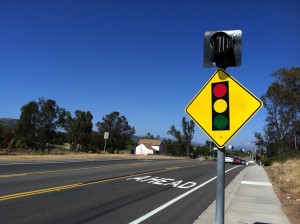With its scenic views and college-town atmosphere, the city of San Marcos has successfully captured the attention of many North County residents.
Yet, even with all the shopping, dining and amenities the town has to offer, it has always been missing a centralized downtown area. That’s about to change now that the city has received environmental approval for the redevelopment of a 214-acre area near San Marcos Creek.
The area will utilize mixed-use development and would include a 71-acre ecological preserve. It would also offer new shopping in the form of a promenade as well as parks and open spaces for visitors to enjoy.
Jerry Backoff, the director of planning for San Marcos, said the recent environmental approval came after two years of work between a redistricting task force comprised of business people, property owners and residents, as well as an outside consulting firm.
The environmental approval needed came from a variety of independent organizations and groups including the Department of Fish and Game, the Environmental Protection Agency and the Regional Water Quality Control Board, among others.
A mixed-use downtown
The impetus for the creation of the downtown area was to attract commerce, according to Backoff, who added that the current view of San Marcos Boulevard from the freeway raised concerns that the city might not be attracting big businesses.
So the task force set out to create a model of a downtown that would attract businesses, and settled on a mixed-use design to create a fresh and new-looking area. Planners from the task force analyzed other working examples of mixed-use cities throughout Southern California and elsewhere in an attempt to form a model for what San Marcos’ downtown should look like, according to Backoff.
“We (looked at) what made these other places a central place and what made these other places unique and prosperous,” Backoff said. “And so we took that vision and that theme and built it into the idea for a specific plan.”
The planning director said that with its environmental approval, the city has had to make various sacrifices during the planning process for the downtown.
“There are certain changes we had to work with them (the various agencies) to accomplish in order to gain the permits,” he said. “We lost some of the development blocks along the creek area west of Via Vera Cruz. Those were required to be eliminated.”
While Backoff said the loss of some development blocks was possibly the most significant change to arise from the necessary environmental approvals, there were various other changes that also took place during the planning process for the city. Certain roadways were turned into bridges and other infrastructure changes were made to meet the requirements of the agencies.
Concerns about the creek
The Environmental Protection Agency raised concerns over the quality of the water in San Marcos Creek due to fears of run-off from the development, prompting the task force to work hand-in-hand with the Regional Water Quality Control Board to devise a solution to the problem.

“One of the most vocal parties that was concerned about this project was the EPA,” water quality control board Executive Director David Gibson said. “At one point, they were threatening to take over jurisdiction from the Army Corps of Engineers because of the size of the project and the concerns that they had.”
But Gibson said that once discussions commenced over the plans for the creek and its water, the EPA recognized that the water would be enhanced rather than harmed.
Originally, the city had planned to channelize the creek from State Route 78 to Lake San Marcos in a concrete trapezoidal channel. This request was denied by the water board on several occasions, so the city tried a new approach, according to Gibson.
The city’s new plan calls for an open-space walking area that will serve as a buffer zone between the proposed development location and the creek. Additionally, each downtown block will receive its own state-of-the-art storm water management system as it is built.
Gibson said that because not all blocks will be built at the same time, this allows San Marcos’ Planning Commission to develop an effective water management strategy from knowledge garnered on a case-by-case basis.
The storm water management and retention systems to be implemented will clean the water before it enters the creek. Gibson said that metals and various pollutants that had previously affected the creek will be removed in a filtration process, thereby leaving the water cleaner than it was before.
Environmental restoration
With some concern over the environmental impact to the surrounding wetlands, the plan also provides for an opportunity to enhance and restore previously damaged wetland areas in San Marcos. Approximately 9.78 acres will be permanently affected.
However, proponents of the project point to the plan’s statement that 23.56 acres of wetland will be established, 1.76 acres will be re-established, 17.12 acres will be enhanced and 17.83 acres will exist between buffers and preservation areas.
Initial construction has yet to take place, according to Backoff, who said the Planning Commission is still working out details in the design process.
Funding for the project is set to come from a series of grants and developer fees, meaning it may take a while until it is completed, he said.
Nevertheless, Backoff and Gibson said they were excited by the project and its positive environmental impact.
“This is the very first 401 certification in the state where we have set measures of biological integrity as a goal and compliance point,” Gibson said, referring to state guidelines for water quality and wetlands. “So far as I know, no other certification in the state of California has done that.”
Alex Groves is a freelance writer in the region



